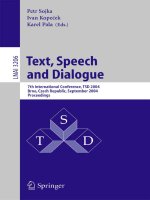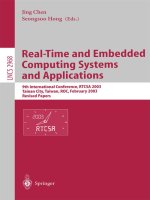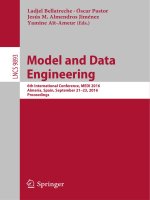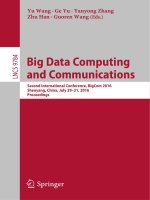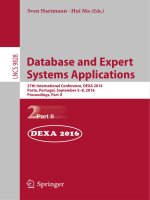Serious games interation and simulation 6th international conference
Bạn đang xem bản rút gọn của tài liệu. Xem và tải ngay bản đầy đủ của tài liệu tại đây (18.27 MB, 170 trang )
Carlos Vaz de Carvalho
Paula Escudeiro
António Coelho (Eds.)
176
Serious Games,
Interaction and Simulation
6th International Conference, SGAMES 2016
Porto, Portugal, June 16–17, 2016
Revised Selected Papers
123
Lecture Notes of the Institute
for Computer Sciences, Social Informatics
and Telecommunications Engineering
Editorial Board
Ozgur Akan
Middle East Technical University, Ankara, Turkey
Paolo Bellavista
University of Bologna, Bologna, Italy
Jiannong Cao
Hong Kong Polytechnic University, Hong Kong, Hong Kong
Geoffrey Coulson
Lancaster University, Lancaster, UK
Falko Dressler
University of Erlangen, Erlangen, Germany
Domenico Ferrari
Università Cattolica Piacenza, Piacenza, Italy
Mario Gerla
UCLA, Los Angeles, USA
Hisashi Kobayashi
Princeton University, Princeton, USA
Sergio Palazzo
University of Catania, Catania, Italy
Sartaj Sahni
University of Florida, Florida, USA
Xuemin Sherman Shen
University of Waterloo, Waterloo, Canada
Mircea Stan
University of Virginia, Charlottesville, USA
Jia Xiaohua
City University of Hong Kong, Kowloon, Hong Kong
Albert Y. Zomaya
University of Sydney, Sydney, Australia
176
More information about this series at />
Carlos Vaz de Carvalho Paula Escudeiro
António Coelho (Eds.)
•
Serious Games,
Interaction and Simulation
6th International Conference, SGAMES 2016
Porto, Portugal, June 16–17, 2016
Revised Selected Papers
123
Editors
Carlos Vaz de Carvalho
Instituto Superior de Engenharia do Porto
Porto
Portugal
António Coelho
University of Porto
Porto
Portugal
Paula Escudeiro
Instituto Superior de Engenharia do Porto
Porto
Portugal
ISSN 1867-8211
ISSN 1867-822X (electronic)
Lecture Notes of the Institute for Computer Sciences, Social Informatics
and Telecommunications Engineering
ISBN 978-3-319-51054-5
ISBN 978-3-319-51055-2 (eBook)
DOI 10.1007/978-3-319-51055-2
Library of Congress Control Number: 2016959800
© ICST Institute for Computer Sciences, Social Informatics and Telecommunications Engineering 2017
This work is subject to copyright. All rights are reserved by the Publisher, whether the whole or part of the
material is concerned, specifically the rights of translation, reprinting, reuse of illustrations, recitation,
broadcasting, reproduction on microfilms or in any other physical way, and transmission or information
storage and retrieval, electronic adaptation, computer software, or by similar or dissimilar methodology now
known or hereafter developed.
The use of general descriptive names, registered names, trademarks, service marks, etc. in this publication
does not imply, even in the absence of a specific statement, that such names are exempt from the relevant
protective laws and regulations and therefore free for general use.
The publisher, the authors and the editors are safe to assume that the advice and information in this book are
believed to be true and accurate at the date of publication. Neither the publisher nor the authors or the editors
give a warranty, express or implied, with respect to the material contained herein or for any errors or
omissions that may have been made.
Printed on acid-free paper
This Springer imprint is published by Springer Nature
The registered company is Springer International Publishing AG
The registered company address is: Gewerbestrasse 11, 6330 Cham, Switzerland
Preface
SGAMES 2016, the 6th EAI International Conference on Serious Games, Interaction
and Simulation, was a multidisciplinary event dedicated to research, practice and
validation in the fields of serious games, interaction, and simulation.
The serious games area focuses on the design, development, use, and application of
games for other purposes than entertainment. The most striking reported effect from the
use of serious games is an increased user motivation and engagement toward the
“serious” objectives. Interaction and simulation are fundamental tools for this motivation and engagement: providing intuitive and innovative forms of interaction with the
game captures the user interest and creating intelligent game play maintains that
interest.
However, in spite of the existing evidence of success, there is still limited use of
serious games. This has mainly to do with social concerns and stereotypes about the
relation of games and serious purposes. But it is also related to the lack of extended
evidence of effective application. This is where SGAMES plays a crucial role as a
forum to exchange knowledge and best-practices and to disseminate that evidence.
The program of SGAMES 2016 reflected the contributions to core issues of serious
game design and development and their application in distinct areas. The keynotes
presented state-of-the-art information about two major topics in this field:
• Sylvester Arnab presented the need to harness the potential of hybrid spaces in
teaching and learning resulting from the merging of digital and physical experiences
and the potential of the playful nature of games and gamification to create contexts
for that pervasive learning process.
• Rui Prada analyzed the use of AI characters with socio-emotional agency that
increase the range of social situations that players can explore in the application of
games to learn social skills.
The definition of models for the collection of usage data (game learning analytics)
was a major concern together with the automatic extraction of gameplay design
expertise, and the development of a requirements definition model for pervasive
games-based learning systems:
• Cano et al. introduce the GLAID (game learning analytics for intellectual disabilities) model that describes how to collect, process, and analyze videogame interaction data in order to provide an overview of the user learning experience, from an
individualized assessment to a collective perspective.
• Vahldick et al. propose a model to identify the students’ progress by recording
(through game learning analytics) their performance in programming tasks. They
demonstrate the model through an implementation in a casual computer programming serious game.
VI
Preface
• Raies et al. propose a process to extract and represent the necessary specialized
knowledge required to design game-based learning systems in order to transfer that
knowledge to novice actors. The process uses ontology techniques based on the
semantic annotation of gameplay descriptions.
• In a related approach, Mejbril et al. propose a model, also based on ontology
techniques, to define a requirements engineering process in order to improve the
development of pervasive game-based learning systems.
Accessibility and social inclusion applications deserved special attention. Articles in
these areas addressed aspects like the phonetics awareness of children with Down
syndrome, the improvement of the learning of child movements, neurocognitive
stimulation and assessment for older people, digital skill building for individuals at
risk, older people’s interaction with digital gaming on consoles and tablets, sign language learning support and task-specific training for rehabilitation purposes:
• Markham et al. present a study where they examined skill acquisition and retention
of a non-injured population performing a sensorimotor navigation task in the
computer-assisted rehabilitation environment (CAREN), driving a virtual boat
through a scene using weight shifting and body movement. They conclude that
task-specific training in immersive VEs may be effective for warfighter operational
skills training and the rehabilitation of wounded warriors, by utilizing tasks that lead
to long-term retention.
• Jali and Arnab present a study investigating the correlation between the challenges
associated with older people, their existing engagement with digital gaming, the
andragogical perspectives and existing game design attributes. Their preliminary
results demonstrated that older people’s initial perspectives and perceptions toward
digital gaming and gameplay were influenced by perceived or assumed difficulties,
but they were changed once they had broken the confidence barrier associated with
engaging with new technologies and experienced the enjoyment from the social
aspects of the engagement.
• Costa et al. present a serious game aiming to analyze neurocognitive deficits and
stimulate the players’ neurocognitive processes. This game is built on top of sound
neurocognitive psychotherapy for adults, mainly addressing the cognitive processes
of attention and memory. The game simulates real-world scenarios, allowing a
better generalization process due to the application of the ecological validity
concept.
• Tsalapatas et al. presented the EMPLOY project that addresses the development of
digital skills among young learners with the objective of enhancing their future
employment opportunities in innovation-related sectors. They conclude that the
integration of technology and pedagogies offer broad learning benefits to both
students and teachers by enhancing motivation, promoting long-term engagement
with the learning process, providing timely and constructive feedback, and promoting critical and entrepreneurial thinking mindsets.
• Simão et al. present a research work that proposes a computer-assisted education
application that aims to teach talking and reading through games. The work
described was carried out in close cooperation with a child-care institution that
works with children with distinct growth disorders, namely, Down syndrome.
Preface
VII
• Raposo et al. present a serious game that tackles developmental coordination disorders that can be identified when children show motor skills below the expected
levels considered adequate for their physical age and through the creation of a
systematic collection of exercises children are able to perform frequently using the
user-friendly game.
• Escudeiro et al. present the evaluation methods and techniques applied to a serious
game developed within the VirtualSign project, a Portuguese sign language
bi-directional translator. The serious game aims to make the process of learning sign
language easier and enjoyable.
• From a more technical perspective, Lopes et al. present a research work that
introduces a new generic software layer between the gesture capture device and the
application level, therefore hindering lower-level, software/hardware details from a
developer and letting him or her focus directly on the application level. This work is
also planned to be used in the context of sign language support.
Other application areas included intelligence analysis and energy efficiency.
• Bourazeri et al. present the Social Mpower game, a representation of an autonomous energy community for local power generation and distribution in which the
participants have to avoid a collective blackout by individually reducing their
energy consumption by synchronizing and coordinating their actions.
• Rudnianski et al. present LabRint, a serious game that provides intelligence analysts
with a set of learning experiences The game focuses on three stages of intelligence
analysis: information collection and structuring, inference schemes development,
and determination of inferences about the issue under scrutiny.
• Cesário et al. present ClueKing a children’s pervasive game that encompasses
context-aware and parent mediation to create an informal learning environment. The
basic concept of ClueKing is an interactive environment where teachers define the
learning goals and challenges and parents mediate their application on the home
setting, on the children’s schedule, and on how to promote their engagement.
Gamification was also approached and its use in software development contexts was
presented.
• Silva et al. present the use of gamification to encourage software developers to use
agile methodologies and tools with the necessary regularity. The main focus of this
work is on the task completion and the regular use of the project management tool,
while insuring the respect of the values proposed by the agile manifesto to software
development.
• Jurado et al. describe a model for the design of game strategies based on related
works in the field of gamification and its applications, composed of three components: a game environment process, a game environment, and a component for
measurement and evaluation. This proposition seeks to offer a methodological tool
for the design of game strategies in the field of gamification, applied to knowledge
management.
VIII
Preface
SGAMES 2016 was also meant to foster interaction and informal networking
between researchers. Taking advantage of the fact that several European R&D project
coordinators attended the conference, an expert panel was organized to discuss several
topics related to the submission and management of these projects, namely:
•
•
•
•
•
How
How
How
How
How
to
to
to
to
to
successfully prepare a project proposal
lead and manage such a complex project
monitor and assess the project development
disseminate and make widely public project results
sustain project results after the life of the project
Finally, another innovation in SGAMES 2016 was the presentation of exemplary
serious games developed in the context of academic studies. The selected serious
games for this show were:
• No Bug’s Snack Bar: A Casual Serious Game to Support Introductory Computer
Programming Learning, by Adilson Vahldick, a game to help learn the initial topics
in introductory computer programming courses
• English Is Cool, by Ana Sousa Silva and Sandra Patricia Queirós, an educational
game to learn basic concepts of English
• Car Driving Simulator, by Vasco Vaz and Alexandre Bastos, a car driving simulator
that helps in learning the basic traffic rules
• Nutrigame, by Francisco Fernandes and Orlando Neves, an adventure game that
develops competences in nutrition
• VirtualSign Game, by Marcelo Norberto, a game aiming to aid the learning of
Portuguese Sign language
• Cognitive Stimulation Game, by Jorge Neto and João Costa, a game that stimulates
the players’ cognitive processes
• Escalada Musical, by Augusto Manuel Bilabila, Fábio Amarante and Mariana
Derigi Ambrózio, a game of musical perception that fits the music education
curricula
SGAMES 2016 was once again an excellent opportunity to be in contact with the
most recent research and development in the serious games domain. The quality of the
contributions and discussions clearly showed tremendous potential for evolution,
which we expect will continue in the next few years. We look forward to seeing you in
2017.
November 2016
Carlos Vaz de Carvalho
António Coelho
Paula Escudeiro
Organization
Steering Committee
Imrich Chlamtac
Carlos Vaz de Carvalho
Create-Net and University of Trento, Italy
Instituto Superior de Engenharia do Porto, Portugal
Organizing Committee
General Chairs
Carlos Vaz de Carvalho
Antonio Coelho
Instituto Superior de Engenharia do Porto, Portugal
University of Porto, Portugal
Technical Program Chair
Paula Escudeiro
ISEP, Porto, Portugal
Workshops Chair
Joze Rugelj
University of Ljubljana, Slovenia
Publicity Chair
Martin Sillaots
Tallinn University, Estonia
Demos and Tutorials
Ivan Martinez-Ortiz
Complutense University of Madrid, Spain
Committee Chair
Panels Chair
Hariklia Tsalapata
University of Thessaly, Greece
Posters and PhD Track Chair
Gavin Sim
University of Central Lancashire, UK
Publications Chair
Leonel Morgado
Universidade Aberta, Portugal
Web Chair
Antonio Andrade
Virtual Campus Lda., Porto, Portugal
X
Organization
Local Organizing Committee
Ana Barata
Bertil Marques
António Castro
Rosa Reis
Dulce Mota
Ricardo Batista
Instituto Superior de Engenharia
Instituto Superior de Engenharia
Instituto Superior de Engenharia
Instituto Superior de Engenharia
Instituto Superior de Engenharia
Universidade do Porto, Portugal
do
do
do
do
do
Porto,
Porto,
Porto,
Porto,
Porto,
Portugal
Portugal
Portugal
Portugal
Portugal
Technical Program Committee
Alfredo Pina
Ana Barata
Andreea Molnar
Anthony Brooks
Antonio Andrade
António Castro
Antonio Coelho
Baltasar Fernandez-Manjon
Bertil Marques
Carina Gonzalez
Carlo Bartolini
Carlos Vaz de Carvalho
Cristiano da Costa
Diana Xu
David Gouveia
Dulce Mota
Elvira Popescu
Etelberto Costa
Francesco Napoli
Gavin Sim
Hariklia Tsalapata
Ivan Martinez-Ortiz
Janet Read
Joze Rugelj
Leonel Morgado
Lucia Bertolini
Manuel Caeiro Rodriguez
Manuela Cantoia
Martin Sillaots
Martin Llamas-Nistal
Olivier Heidmann
Paula Escudeiro
Pascual Lahuerta
Pedro Cardoso
Universidad de Navarra, Spain
Instituto Superior de Engenharia do Porto,
Portsmouth University, UK
Aalborg University, Denmark
Virtual Campus Lda., Porto, Portugal
Instituto Superior de Engenharia do Porto,
University of Porto, Portugal
Complutense University of Madrid, Spain
Instituto Superior de Engenharia do Porto,
Universidad de la Laguna, Spain
e-Campus, Novedrate, Italy
Instituto Superior de Engenharia do Porto,
Unisinos, Brazil
University of Central Lancashire, UK
Virtual Campus, Portugal
Instituto Superior de Engenharia do Porto,
University of Craiova, Romania
APG, Portugal
e-Campus, Novedrate, Italy
University of Central Lancashire, UK
University of Thessaly, Greece
Complutense University of Madrid, Spain
University of Central Lancashire, UK
University of Ljubljana, Slovenia
Universidade Aberta, Portugal
e-Campus, Novedrate, Italy
Universidad de Vigo, Spain
e-Campus, Novedrate, Italy
Tallinn University, Estonia
Universidad de Vigo, Spain
University of Thessaly, Greece
ISEP, Porto, Portugal
Universidad de Valencia, Spain
Universidade do Porto, Portugal
Portugal
Portugal
Portugal
Portugal
Portugal
Organization
Peter Van Rosmalen
Ricardo Batista
Roberto Guerrero
Romain Raffin
Rosa Reis
Rui Nóbrega
Rui Rodrigues
Sandra Baldassarri
Sandro Rigo
Stefano Za
Tobias Mülling
Wouter Sluis-Thiescheffer
Welten Institute, The Netherlands
Universidade do Porto, Portugal
Universidad de San Luís, Argentina
Aix-Marseille University, CNRS, France
Instituto Superior de Engenharia do Porto, Portugal
University of Porto, Portugal
University of Porto, Portugal
Universidad de Zaragoza, Spain
Unisinos, Brazil
eCampus University, Italy
Universidade Federal de Pelotas, Brazil
Fontys Applied University of ICT, Germany
XI
Contents
Using Games for the Phonetics Awareness of Children
with Down Syndrome . . . . . . . . . . . . . . . . . . . . . . . . . . . . . . . . . . . . . . .
José Simão, Luísa Cotrim, Teresa Condeço, Tiago Cardoso,
Miguel Palha, Yves Rybarczyk, and José Barata
1
Playful and Gameful Learning in a Hybrid Space . . . . . . . . . . . . . . . . . . . .
Sylvester Arnab
9
Improving the Learning of Child Movements Through Games . . . . . . . . . . .
Miguel Raposo, Raquel Barateiro, Susana Martins, Tiago Cardoso,
Miguel Palha, and José Barata
15
ClueKing: Allowing Parents to Customize an Informal Learning
Environment for Children. . . . . . . . . . . . . . . . . . . . . . . . . . . . . . . . . . . . .
Vanessa Cesário, Valentina Nisi, and António Coelho
23
The Importance of Socio-Emotional Agency in Applied Games
for Social Learning . . . . . . . . . . . . . . . . . . . . . . . . . . . . . . . . . . . . . . . . .
Rui Prada
31
Learning Analytics Model in a Casual Serious Game for Computer
Programming Learning . . . . . . . . . . . . . . . . . . . . . . . . . . . . . . . . . . . . . .
Adilson Vahldick, António José Mendes, and Maria José Marcelino
36
GLAID: Designing a Game Learning Analytics Model to Analyze the
Learning Process in Users with Intellectual Disabilities . . . . . . . . . . . . . . . .
Ana R. Cano, Baltasar Fernández-Manjón,
and Álvaro J. García-Tejedor
Automatic Extraction of Gameplay Design Expertise: An Approach Based
on Semantic Annotation. . . . . . . . . . . . . . . . . . . . . . . . . . . . . . . . . . . . . .
Kaouther Raies, Maha Khemaja, and Yemna Mejbri
Designing Game Strategies: An Analysis from Knowledge Management
in Software Development Contexts . . . . . . . . . . . . . . . . . . . . . . . . . . . . . .
Jose L. Jurado, Cesar A. Collazos, Francisco L. Gutierrez,
and Luis M. Paredes
Neurocognitive Stimulation Game: Serious Game for Neurocognitive
Stimulation and Assessment . . . . . . . . . . . . . . . . . . . . . . . . . . . . . . . . . . .
João Costa, Jorge Neto, Ricardo Alves, Paula Escudeiro,
and Nuno Escudeiro
45
53
64
74
XIV
Contents
The Perspectives of Older People on Digital Gaming: Interactions
with Console and Tablet-Based Games . . . . . . . . . . . . . . . . . . . . . . . . . . .
Suriati Khartini Jali and Sylvester Arnab
82
A Serious Game for Digital Skill Building Among Individuals at Risk,
Promoting Employability and Social Inclusion . . . . . . . . . . . . . . . . . . . . . .
Hariklia Tsalapatas, Olivier Heidmann, and Elias Houstis
91
Learning and Long-Term Retention of Task-Specific Training
in a Non-injured Population Using the Computer Assisted Rehabilitation
Environment (CAREN) . . . . . . . . . . . . . . . . . . . . . . . . . . . . . . . . . . . . . .
Amanda E. Markham, Kathrine A. Service, John-David Collins,
and Pinata H. Sessoms
99
Sign Language Support – Adding a Gesture Library
to the Leap Motion SDK . . . . . . . . . . . . . . . . . . . . . . . . . . . . . . . . . . . . .
Tiago Lopes, Tiago Cardoso, and José Barata
109
VirtualSign Game Evaluation . . . . . . . . . . . . . . . . . . . . . . . . . . . . . . . . . .
Paula Escudeiro, Nuno Escudeiro, Marcelo Norberto, and Jorge Lopes
Towards an Ontology of Requirements for Pervasive Games Based
Learning Systems: A Requirements Engineering Perspective. . . . . . . . . . . . .
Yemna Mejbri, Maha Khemaja, and Kaouther Raies
117
125
Social Mpower: An Educational Game for Energy Efficiency . . . . . . . . . . . .
Aikaterini Bourazeri, Jeremy Pitt, and Sylvester Arnab
133
Gamification at Scraim . . . . . . . . . . . . . . . . . . . . . . . . . . . . . . . . . . . . . .
Diogo Silva, António Coelho, César Duarte,
and Pedro Castro Henriques
141
The LabRint Serious Game: A New Intelligence Analysis Methodology . . . .
Michel Rudnianski, Olivier Heidmann, Raphael Attias,
and François Mohier
148
Author Index . . . . . . . . . . . . . . . . . . . . . . . . . . . . . . . . . . . . . . . . . . . .
157
Using Games for the Phonetics Awareness
of Children with Down Syndrome
José Simão1, Luísa Cotrim2, Teresa Condeço2, Tiago Cardoso1(&),
Miguel Palha2, Yves Rybarczyk1,3, and José Barata1
1
UNINOVA, DEE, FCT, Universidade Nova de Lisboa,
2825-516 Caparica, Portugal
, {tomfc,jab}@uninova.pt,
2
Centro Diferenças – Centro de Desenvolvimento Infantil,
2825-516 Caparica, Portugal
{luisacotrim,miguelpalha}@diferencas.net,
3
MIST, Universidade Tecnológica Indoamérica, Quito, Ecuador
Abstract. Computers and technology can play a key role in supporting
learning, namely for students with special educational needs. Nevertheless,
despite the emphasis the society puts on the use of technology and its fast
proliferation in the area of education, few initiatives focus on the specific needs
of children with disabilities. Motivated by this gap, this research work proposes
a computer assisted education application that targets to teach talking and
reading through games. The work described herein was carried out in close
cooperation with Centro Diferenças - Centro de Desenvolvimento Infantil, a
child-care institution that works with children with distinct growth disorders,
namely the Down syndrome.
Keywords: Down syndrome Á Multi-platform Á PhaserJS Á Educational games Á
Neuro-development Á E-learning
1 Introduction
The availability and accessibility to technology is rapidly growing. In Portugal, during
the year 2014 it was registered that 70% of Portuguese households had internet access
within the home and 66% were able to access the internet outside the home and
workplace with the use of mobile devices [1]. Taking into account the large amounts of
existing devices, the opportunity arises to make use of technology to solve day-to-day
problems.
Technological advances as related to educational tools is one key area that has
received increased attention. With this, several applications and tools have been
devised to assist in both the accessibility to information as well as in the education
element itself [8–10].
Learning to read is a complex and challenging task which requires explicit teaching
and considerable practice to acquire. It involves two interacting, but separate,
© ICST Institute for Computer Sciences, Social Informatics and Telecommunications Engineering 2017
C. Vaz de Carvalho et al. (Eds.): SGAMES 2016, LNICST 176, pp. 1–8, 2017.
DOI: 10.1007/978-3-319-51055-2_1
2
J. Simão et al.
components which are key to effectively reading: word recognition and language
comprehension. Work with typically-developing children has identified phonological
awareness and letter knowledge to be essential for the development of alphabetic
reading. Phonological awareness being defined as the ability to reflect on the sound
structure of speech and is assessed by tasks which require children to separate words
into syllables, identify and produce rhymes, match words that begin with the same
sound, and to manipulate individual sounds (or ‘phonemes’) in words, for example by
blending, segmenting and deleting them. As evidenced, there is clearly a need for
further research to evaluate those methods which appear promising for supporting
reading in children with Down syndrome, using well-designed and controlled research
methods. In addition, despite recent advances in knowledge, it remains significant areas
in which our understanding is lacking, and this is particularly true for comprehension.
More research is needed to explore the comprehension skills of children with Down
syndrome, and to evaluate methods of instruction which may support the development
of this skill [2]. The number and quality of existing electronic tools to assist these
children in their learning process have proved to be limited.
To help address this problem, specialized associations have begun to partner with
universities. One example of this type of initiative is the partnership formed between the
“Centro Diferenças” and the “Faculdade de Ciências Tecnologias da Universidade Nova
de Lisboa”. Through such partnerships, commitments to create and continue the
development of several tools to help in the education and integration of these children
have been initiated, some of them within the area of neuro-development. In Portugal, 1
in 800 children are born with Down syndrome [3]. These children face day-to-day
learning challenges, such as attention deficit disorders, difficulties in associating objects
with words, etc. Despite these statistics and facts, as dispelled within the “Down Syndrome Fact Sheet” of the National Down Syndrome Society (www.NDSS.org),
although all people with Down syndrome experience cognitive delays, the effect is
usually mild to moderate and is not indicative of the many strengths and talents that each
individual possesses. People with Down syndrome attend school, work, participate in
decisions that affect them, have meaningful relationships, vote and contribute to society
in many wonderful ways. Inclusively life expectancy for people with Down syndrome
has increased dramatically in recent decades – from 25 in 1983 to 60 today [4].
Perhaps the most important lesson learned through the course of this project, is one
also shared within another study on online learning tools for individuals with Down
syndrome, whereas in spite of the many unknowns and challenges in embarking on
such endeavor if time is taken to value and understand design from the user’s perspective, one can chart unknown territory and yield transformational results. This view
embodying and setting forth the overarching goal of this work [2].
2 Proposal
As part of this project, a set of functional and non-functional requirements were
devised. According to Makesys, the functional ones define a software function or a part
thereof. The non-functional ones are related to the performance of the application while
it is being used, as well as restrictions on the functional requirements [5].
Using Games for the Phonetics Awareness of Children with Down Syndrome
3
Fig. 1. Architecture description, where it can be observed how the clients will access the
application as well as how their communication will work.
Considering all specified requirements, an architecture was created with the following components: one database, one Application Program Interface (API) and one
game (Fig. 1). The use of the API was essential to establish the connection between all
the components as previously described, as well as allowing for changes to each one of
these without affecting the behavior of the other components.
Game The game consists of several mini-games that are designed to address a specific
issue in order to most effectively teach the individual player. There are 7 mini-games:
• 2 designed to teach the association of images with words or phrases.
• 2 intend to teach the child how to separate components present in the sounds of the
images and to force them to count the number of previously-separated components.
• 2 intend to teach the child how to associate words and objects - in this particular
case, associating words and similar objects based on their sound.
• Finally, the last mini-game aims to teach the child how to make associations
between a grapheme (smallest meaningful contrastive unit in the writing system [7])
and a phoneme (any of the perceptually distinct units of sound in the specified
language that distinguishes one word from another [7]).
The application should be equipped with a data recording process which provides
for the recording of data at the end of each level, so as to avoid excessive use of memory.
This process should be fluid and must never interrupt the natural flow of the game.
2.1
Mini-Games: “Palavra-a-Palavra” and “Fraseando”
The model presented by the “Centro Diferenças” for the mini game “Palavra-a-Palavra
and Fraseando“is based on the repetition of a word or phrase, while the child is being
shown a picture (Fig. 2). The image display will be chosen at random and displayed in
4
J. Simão et al.
Fig. 2. Screenshot from the mini-game “Palavra-a-Palavra” with layout explained
the center of the screen. The goal of this exercise is to teach the child to speak using
images as corresponding to the text in order to provide a visual support. This method
was previously tested and is proven to increase the child’s understanding and information recall [6].
2.2
Mini-Games: “Palavras a Rimar” and “Sons Iniciais”
The main objective of these mini-games is to prompt the user to find a relationship
between the referenced image and options provided. In both games, several images are
displayed to the user. One will be the reference and the remaining will be the options
that may be selected. In the mini-game “Palavras a Rimar”, the user must identify the
images that have rhyming sounds. For the “Sons Inicias” mini-game, the user must
identify the images that have words that begin with the same sound (Fig. 3).
In this mini-game two buttons, one in green and another in yellow is utilized to
record the responses. The yellow is used to lock the answer and the green button is used
to confirm the answer as entered.
2.3
Mini-Games: “Contar as Palavras” and “Contar Os Bocadinhos”
The mini-games “Contar as Palavras” and “Contar os Bocadinhos” aims to divide a
word and force the student to count the number of words which can be divided into
phonemes or syllables. The game “Contar as Palavras” will divide words into phonemes and will force the student to count the number of phonemes (Fig. 4). In the case
of the game “Contar os Bocadinhos”, the word is divided into syllables. Students may
proceed to the next image once you have chosen the right amount of syllables or
phonemes.
Using Games for the Phonetics Awareness of Children with Down Syndrome
5
Fig. 3. Screenshot from the mini-game “Sons Iniciais” (Color figure online)
Fig. 4. Screenshot from the mini-game “Contar as Palavras”
2.4
Mini-Game: “Guardar os Sons”
“Guardar os Sons” is a mini-game to teach the user to make associations between a
grapheme and a phoneme (Fig. 5). After the start of this mini-game, two random
figures together with an associated sound are presented. The child will then have the
opportunity to drag the image to one of the chests that represents the corresponding
grapheme. If the child drags the image to an incorrect chest, the image will return to its
original position.
6
J. Simão et al.
Fig. 5. Screenshot from the mini-game “Guardar os Sons”
3 Validation
This research initiative took place within the Social Tech Booster ()
branch from the Robotics and Industrial Complex Systems (RICS) research group,
trying to solve a concrete problem and pursuing the real deployment of the result, as
illustrated in [11].
The validation of this research work was divided into two phases: 1 - the development of a prototype system with the above-mentioned seven mini-games; and 2 – the
testing of these games with learning impaired children, i.e., with Down syndrome.
Implementation - Different methods and tools were considered as part of this project.
The tools as selected included PhaserJS. This was primarily due to being an
open-source system coupled with the level of support provided to the users either by
tutorials, or examples as included in its official website. The need to create an API
using RESTful Web Services was identified during the project development. It was
responsible for the communication between different components. The API also served
as a possible interface for the user, in a manner that s/he could access their information
along with its restricted modifications within its security parameters.
Validation of the Experimental Data - Between the period of the 5th of October and
the 2nd of December, data for three children with Down syndrome from the “Centro
Diferenças” was gathered as part of this project. The data as collected, represented a
total of 3 sessions for each child with varying spacing between the individual sessions.
The sessions contained information from the various mini-games.
Every correct answer from the player received a score of 10 points, and every wrong
answer received 0 points. The evaluation of the improvement is based on comparing
scores between individual sessions. If the score is higher, the child improved and learned
something, if the score is lower, the child did worse and did not demonstrate any
improvement. The statistics of three children are shown in Tables 1, 2 and 3.
Using Games for the Phonetics Awareness of Children with Down Syndrome
7
Table 1. Sample results for child number 1
Mini games\Days
Palavra a Palavra
Fraseando
Guardar os Sons
Contar os Sons
Palavras a Rimar
Contar os Bocadinhos
Day 1 Day 2 Day 3 Analysis
50
50
50
Maintained
0
0
10
Improved
40
40
x
Maintained
50
10
x
Diminish
10
20
x
Improved
50
50
50
Maintained
Table 2. Sample results for child number 2
Mini games\Days
Palavra a Palavra
Fraseando
Guardar os Sons
Contar os Sons
Palavras a Rimar
Contar os Bocadinhos
Day 1 Day 2 Day 3 Analysis
10
10
50
Improved
0
10
10
Improved
0
10
x
Improved
x
x
x
No Data
0
10
0
Diminish
0
40
30
Improved
Table 3. Sample results for child number 3
Mini games\Days
Palavra a Palavra
Fraseando
Guardar os Sons
Contar os Sons
Palavras a Rimar
Contar os Bocadinhos
Day 1 Day 2 Day 3 Analysis
0
50
x
Improved
0
10
x
Improved
40
x
x
Not enough Data
x
x
x
No Data
0
10
x
Improved
0
50
x
Improved
4 Conclusions and Future Work
The conclusions drawn were that:
• In a universe consisting of 6 distinct mini-games, 83.3% of the mini-game universe
showed an improvement in the children’s scores between individual sessions. The
total universe of the mini-games should have been 7, however, one mini-game was
excluded as data was not available.
• Two mini-games were subject of negative results, but only one had 100% negative
results, the other game had 2 children showing improvement and one negative
performance.
• In 5 of the 6 mini-games (83.3%), 2 of the 3 children (66.67%) showed
improvement in their overall results.
8
J. Simão et al.
• The activities that demonstrated the most improvement were those as specific to the
image association with the object and the separation of the image into sounds along
with its count.
For final consideration, it should be noted that based on results obtained, great
success was highlighted and continued initiatives should be undertaken to improve the
mini-game that was subject of negative results.
References
1. Instituto Nacional de Estatística, Statistical Yearbook of Portugal (2014).
2. Assadour, K., Matthew, M.: Web Fun Central: Online Learning Tools for Individuals with
Down Syndrome. John Wiley & Sons, Ltd., Hoboken. ISBN: 13:978-0-470-01866-8
3. Correio da Manhã. />4. National Down Syndrome Society. />5. Makesys Fábrica de Software.
6. Kelly, B.: Reading interventions for children with Down syndrome, Down Syndrome
Research and Practice, pp. 1–6. Advance Online Publication
7. Oxford Leaner’s Dictionaries.
8. Sybenga, S., Rybarczyk, Y.: Using machine learning and image processing for character
recognition: an application for teaching handwriting. In: 28th International Conference on
Computer Applications in Industry and Engineering, San Diego, USA (2015)
9. Gameiro, J., Cardoso, T., Rybarczyk, Y.: Kinect-Sign: teaching sign language to “listeners”
through a game. In: Rybarczyk, Y., Cardoso, T., Rosas, J., Camarinha-Matos, L.M. (eds.)
eNTERFACE 2013. IFIP AICT, vol. 425, pp. 141–159. Springer, Heidelberg (2014). doi:10.
1007/978-3-642-55143-7_6
10. Carrasco, G., Rybarczyk, Y., Cardoso, T., Martins, I.P.: A serious game for multimodal
training of physician novices. In: 6th International Conference of Education, Research and
Innovation, Seville, Spain (2013)
11. Cardoso, T., Santos, V., Santos, C., Barata, J.: Games’ “Social Tech Booster”. Serious
Games, Interaction, and Simulation, pp. 119–126 (2016)
Playful and Gameful Learning
in a Hybrid Space
Sylvester Arnab(&)
Disruptive Media Learning Lab, Coventry University, Coventry, UK
Abstract. There is a need to harness the potential of a hybrid space in teaching
and learning as digital and physical experiences are merging and it is essential
that the experience empowers the minds and practices, bridges formal and
informal contexts and deepens the learning process. This paper elaborates on the
playful nature of the use of games and gamification in creating contexts to a
pervasive learning process including the Horizon 2020 Beaconing project as an
example.
Keywords: Serious games
learning
Á
Gamification
Á
Playful learning
Á
Pervasive
1 Introduction
Key to reducing the barriers of time and physical space in learning is to open up
education in such a way that formal and informal learning contexts, and digital and
physical experiences are blended – a hybrid learning space. Exploiting current
advances in digital technologies allow for learning processes to be better situated in a
learner’s context, needs and surroundings, where many different forms of learning
experience can be combined in working toward the desired learning outcomes. Learning should be pervasive in order to exploit the values different learning
preferences, environments and contexts can collectively bring into the experience.
This paper touches on the need to support learning in a hybrid space, specifically
the initiative within the Beaconing project funded by the European Horizon 2020
programme. The pervasive nature of anytime-anywhere learning investigated in the
project aims to provide an avenue for self-regulated learning to be nurtured, where the
role of learners will be amplified in the process of knowledge curation, application and
sharing framed under investigative, collaborative and exploratory scenarios.
2 Learning Experience in a Hybrid Space
Recognition of informal learning as an extension to formal methods is an important
means for promoting anytime anywhere and lifelong learning and, subsequently, for
reshaping learning to better match the needs of the 21st century knowledge economies
and open societies. To support this extension, it is important for educational institutions
to evaluate and possibly re-design how formal spaces are being used in teaching and
© ICST Institute for Computer Sciences, Social Informatics and Telecommunications Engineering 2017
C. Vaz de Carvalho et al. (Eds.): SGAMES 2016, LNICST 176, pp. 9–14, 2017.
DOI: 10.1007/978-3-319-51055-2_2
10
S. Arnab
learning and how digital platforms can help facilitate delivery, application and
assessment of learning in informal context.
Through the years, digital platforms ranging from e-learning and simulation platforms to game-based learning and mobile applications have provided alternative means
for the way learning contents are being delivered. The inclusion of digital tools in
learning has to be holistic as the learning experience may focus too much on digital and
virtual activities, which could lead to disparities between virtual/digital and real
capabilities [1, 2], confidence and self-awareness.
Therefore, there is a need to harness the potential of a hybrid space in teaching and
learning. Digital and physical experiences are merging, and it is essential that the
experience empowers the minds and practices, and deepens the learning process. With
the advancement of Internet of Things (IoT), wearable technologies, mobile and mixed
reality, a more hybrid and connected experience and space can be designed and
developed. Moreover, as the discipline of seamless learning merges the technological
and human challenges faced by the emerging new technologies of the last decade, it is
becoming clear that the ultimate learning environment will have to provide a smooth
learner experience, with options to both consume and create content [3] in both formal
and informal setting. A more sustained and seamless engagement is a key challenge
that needs to be addressed in the design of such an environment.
3 Playful and Gameful Learning
Play is key to intrinsically expanding and broadening our embodied experience with
our surroundings, fostering autonomy and freedom. It is an exploratory and experiential
means for incrementally, iteratively and continuously updating our understanding and
interpretation of the various concepts, objects, people, emotions and the mapping
between these variables [4, 5]. It is a complex process that is difficult to decode and
measure. We are however in the world where almost everything is measured and within
the context of education, measures and assessments are key to ensuring that the
learning process leads to the desired learning outcomes and some forms of certification.
With these perspectives, for play to be included in learning to increase motivation
intrinsically, it will have to be more structured and “formal”, adhering to the play-learn
rules and associated measures. How do we design this playful and gameful experience
without making it too restricting and to allow the feedback cycle to be as natural as
possible so that it may add to the “play” experience? “This shouldn’t be construed as a
claim that “everything is a game.” Games are a particular manifestation of play, not
its totality. They happen to be a good starting point for an investigation of play because
the formality of their rules makes the machinery of play easier to observe and analyse”
[6]. Hence, games are a means by which play can be observed in a more objective way,
which will lead to purposeful and meaningful engagement.
The increasing use of games in non-entertainment contexts, also known as Serious
Games (SG) is transforming everyday lives and most importantly injecting more fun in
everyday contexts [7]. The power of games to immerse and motivate [8, 9] and the
capabilities of games to foster and facilitate cognitive gain, awareness, and behavioral
change have encouraged more games of this nature to be developed within a research
Playful and Gameful Learning in a Hybrid Space
11
context as well as to be deployed in real application settings. There is also an increasing
use of games techniques in non-game contexts known as Gamification [10], which
demonstrated potential impact in improving engagement, nurturing attitude and
behaviour, and facilitating learning in a wide range of subjects [11].
4 Pervasive Games and Gamification
The diminishing boundaries between physical and digital spaces provide great
opportunities for game-based learning approaches (serious games and/or gamification)
to be applied in everyday contexts. Game mechanics are becoming more pervasive as
real and virtual interactions and events are merged within the context of game-play.
Advances in ubiquitous computing, mobile and location-based technologies open
up opportunities for digitally-enabled learning to be facilitated in everyday spaces,
increasing flexibility for learning experience to be made more engaging, contextualized
and seamless. With game-based learning in mind, potentials include educational games
taking place in the physical world, concurrently with the normal activities of learners’
everyday lives, where virtual actions may be the trigger for physical actions in the real
world and vice versa [12]. Ubiquity is expanded by context awareness, a term that
“describes the ability of the computer to sense and act upon information about its
environment, such as location, time, temperature or user identity” [13]. This information can be used to enable selective responses such as triggering events or retrieving
and prompting information relevant to the task at hand. This affords virtualisation,
which provides a more seamless means to link formal and informal learning approaches, and blend digital and physical learning mechanics. Example games adopting such
a pervasive approach, which can be used as inspirations for a more playful and pervasive learning process include Zombies Run1 - an adventure location-based mobile
game that advocates running and Ingress2 and PokemonGo – pervasive games that
transform local landmarks into game objects in a viral and global gaming.
5 Exploring Pervasive and Gamified Learning via Beaconing
By further investigating how learners use the different spaces for learning, how to
exploit learners’ preferences for enhancing the use of digital platforms and the potential
of gamification, pervasive gaming and context-aware technologies in enhancing a
blended learning process, the expected benefits of blended spaces and contexts can be
optimised.
The Beaconing project (beaconing.eu) funded by the European Commission
Horizon 2020 programme investigates playful approaches for digitally enabling
play-learn in everyday spaces fostering cross-subject learning. Figure 1 illustrates the
pervasive learning concept that will be supported by the play-lesson plan.
1
2
/> />




